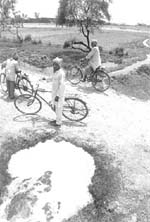Hide Burns
 in 1995, when Krishna Devi of Motipur village in Kanpur, Uttar Pradesh, had rashes all over her body she dismissed it as a minor ailment. But five years and several visits to the doctor later, the rashes have turned into large boils and the pain is excruciating. She spends Rs 300 every month on medicines.
in 1995, when Krishna Devi of Motipur village in Kanpur, Uttar Pradesh, had rashes all over her body she dismissed it as a minor ailment. But five years and several visits to the doctor later, the rashes have turned into large boils and the pain is excruciating. She spends Rs 300 every month on medicines.
Sita Ram, 70, of Kishanpur village is living with an even more gruesome ailment. In the last couple of years, his fingers and toes have started rotting away. For a person who was active in the fields until recently, walking is now becoming an impossible task.
Krishna Devi and Sita Ram are just two of the many people afflicted by rare skin diseases. People in 20 villages living in the vicinity of the Jajmau tannery area in the city are in the grip of severe epidemic-like conditions. While most elders have varying degrees of stomach problems and skin diseases, the children are the worst affected. Worms pop out from their mouths each time they vomit. It is alleged that the cause for the malady is the tannery discharge, which finds its way into the irrigation canal reaching these villages.
"Till 1992, the water we got in the canal carried Kanpur sewage but was diluted by the water from Ganga. The agriculture produce was excellent and this area was famous for its roses. But after the construction of a common effluent treatment plant ( cetp ) at Jajmau, the canal was polluted by the effluents,' says Sukhdev Yadav, a village elder from Motipur who has witnessed pollution take a toll on their lives.
It has been eight years since the first cetp at Jajmau was commissioned under the first phase of the Ganga Action Plan ( gap ). With the demand for raw leather increasing, the number of tanneries in the area has increased threefold from 1992 till now, and along with that the pollution load. Of the 300-odd tanneries functioning in the area, only 14 have chrome recovery plants and the rest discharge their effluents untreated. Hence, even the two sewage treatment plants with a capacity of 5 million litres per day (mld) and 130 mld respectively and 36 mld cetp are unable to handle the waste generated.
There are two channels built to prevent the discharge of this treated and untreated effluent into the Ganga. Both find their way into a sewage farm. However, for the last couple of years, due to one of the channels being under repair, two-thirds of the effluent is being discharged straight into the Ganga and the rest of it into the irrigation canal. Besides, the problem is heightened by the fact that there is hardly any electricity to keep the plants going. It has resulted in untreated effluents being released into the channels and the Ganga all day long as tanneries continue production using generators.
A study conducted by the Central Pollution Control Board ( cpcb ) in 1995 showed high levels of alkalinity, hardness, dissolved solids, iron and lindane
